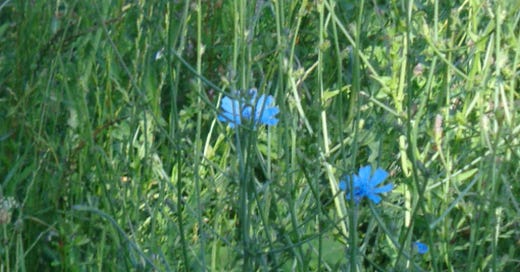I went out this morning to check that I had once again forestalled a fox attack on the hen house. The time was 5 o’clock, but I had no need of a watch to tell me this. Why? Because the wild chicory in the paddock was unveiling its exquisitely sky-blue and dandelion-like petals. Bright flowers to announce a bright new day. Wildflowers are time-indicators. Nature’s clocks, and in Britain’s countryside there are sufficient to get you through the day. Like chicory, poppy chimes early in the morning, while Nottingham catchfly lies lazily abed till seven in the evening. Carl Linnaeus, the Swedish scientist and ‘father of taxonomy’, famously noted the botanical rhythm of flora, and how species differed from each other in their timekeeping, when out sauntering in the summery Swedish countryside. Enchanted with the reliability of ‘clock flowers’, or ‘aequintocales’, Linnaeus devised a full-scale Horologium Florae in 1745 for the botanical garden of Uppsala. This arranged the timely plants in the shape of a clock face, dividing the bed into twelve segments. A living clock. The wedding of Horticulture to Horology. To Linnaeus go the bouquets, but ‘clock flowers’ were already well known before he gazed at goatsbeard and pondered proliferous pinks. The English poet Andrew Marvell described an elementary floral dial in 1678: Of flow’rs and herbs this dial new; / Where from above the milder sun/ Does through a fragrant zodiac run;/ And, as it works, th’ industrious bee/ Computes its time as well as we. / How could such sweet and wholesome hours/ Be reckoned but with herbs and flow’rs?/ The common daisy on the lawn was anciently ‘Day’s Eye’, a modernizing of the ninth-century Anglo-Saxon dæges eˉage. In this island we have been telling time by the flora of wayside and mede, wood and water’s edge since the Neolithic dawn. The people of the past were like flowers, their lives regulated by the length of natural light; they were ‘photoperiodic’ themselves. Their days began at bindweed’s opening, they slipped off to bed at cowslip’s. Scientists pose a theorem that the opening and closing of wildflowers is all about competition and pollination. If every flower were open 24/7 the bustling bees and hither-thither hoverflies would be overwhelmed by choice, so some flowers would be unvisited. Whether designed or evolved, our British wildflowers remain as reliable as any time-keeper planted in a Scandinavian botanical garden. To use a floral dial is to live in the old ways, to find a more natural rhythm, to revolt against the tyranny of the timepiece and the iPhone. A BRITISH WILDFLOWER CLOCK Morning IV Goatsbeard opens V Poppy, Chicory open VI Bindweed, Common Nipplewort open VII Coltsfoot, Buttercup open VIII Cowslip, Scarlet Pimpernel, White Water Lily, Rough Dandelion open IX Lesser Celandine, Daisy, Proliferous Pink open X Sorrel opens XI Common Sow Thistle, Star-of-Bethlehem open XII Goatsbeard, Common Nipplewort close Afternoon I Proliferous Pink closes II Scarlet Pimpernel closes III Rough Dandelion closes IV Coltsfoot, Sorrel, Chicory close V Water Lily closes VI Poppy closes VII Nottingham Catchfly opens VIII Evening Primrose opens IX Cowslip closes. Time for bed, says Flora.
Discussion about this post
No posts





I have to echo how magical this is. My days will begin more gently and naturally knowing that I am unfurling and rising at bindweed’s opening, rather than lurching awake afraid I've an intruder ('Oh no, all okay, it's just the Today programme coming on') or the terrified rousing that follows the emergency alarm clock. Buttercup opening sounds a real treat of a lie-in too.
I loved this. The way you combine information with lyricism is a master class in nature writing.